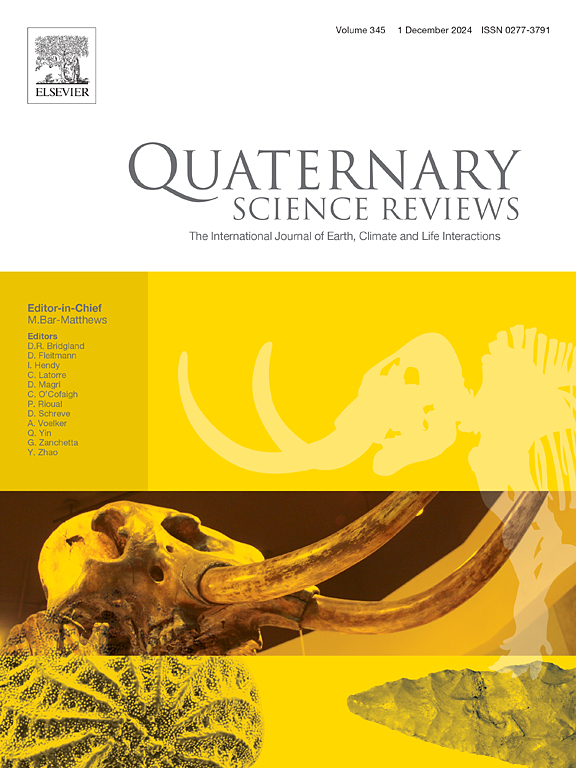The importance of tropical tree-ring chronologies for global change research
IF 3.2
1区 地球科学
Q1 GEOGRAPHY, PHYSICAL
引用次数: 0
Abstract
Tropical forests and woodlands are key components of the global carbon and water cycles. Yet, how climate change affects these biogeochemical cycles is poorly understood because of scarce long-term observations of tropical tree growth. The recent rise in tropical tree-ring studies may help to fill this gap, but a large-scale quantitative analysis of their potential in global change research is missing.
We compiled a list of all tropical tree species known to form annual tree rings and built a network encompassing 492 tropical ring-width chronologies to evaluate the potential to generate insights on climate sensitivity of woody productivity and to build centuries-long reconstructions of climate variability. We assess chronology quality, length, and climatic representativeness and explore how these change along climatic gradients. Finally, we applied species-distribution modeling to identify regions with potential for tree-ring studies in ecological and climatic studies.
The number of tropical chronologies has rapidly increased, with ∼400 added over the past two decades. Yet, tree-ring studies are biased towards high-elevation locations, with gaps in warmer and wetter climates, on the African continent, and for angiosperm species. The longest chronologies with strongest climate signals (i.e., synchronous growth variations among trees) are from cool regions. In wet regions, climate signals and precipitation sensitivity decrease. Most tropical regions harbor 5–15 (and up to 80) species with proven potential to generate chronologies. The potential for long climate reconstructions is particularly high in drier high elevation sites. Our findings support strategies to effectively expand tree-ring research in the tropics, by targeting specific species and regions. Tropical dendrochronology can importantly contribute to global change research by generating historical context of climate extremes, quantifying climate sensitivity of woody productivity and benchmarking vegetation models.

热带树木年轮年表对全球变化研究的重要性
热带森林和林地是全球碳和水循环的关键组成部分。然而,由于缺乏对热带树木生长的长期观测,人们对气候变化如何影响这些生物地球化学循环知之甚少。最近热带树木年轮研究的增加可能有助于填补这一空白,但是缺乏对它们在全球变化研究中的潜力的大规模定量分析。我们编制了一份已知形成年轮的所有热带树种的清单,并建立了一个包含492个热带年轮宽度年表的网络,以评估对木材生产力的气候敏感性产生见解的潜力,并建立了长达几个世纪的气候变化重建。我们评估年表质量、长度和气候代表性,并探索这些因素如何沿着气候梯度变化。最后,我们应用物种分布模型确定了在生态和气候研究中具有树木年轮研究潜力的区域。热带年表的数量迅速增加,在过去二十年中增加了约400种。然而,树木年轮研究偏向于高海拔地区,在温暖和潮湿的气候中存在空白,在非洲大陆,以及被子植物物种。具有最强气候信号的最长年表(即树木之间的同步生长变化)来自凉爽地区。在潮湿地区,气候信号和降水敏感性降低。大多数热带地区都有5-15种(最多80种)已被证实有可能产生年表的物种。在干燥的高海拔地区,长期气候重建的潜力尤其大。我们的研究结果支持通过针对特定物种和地区有效扩大热带树木年轮研究的策略。热带树木年代学可以通过生成极端气候的历史背景、量化木材生产力的气候敏感性和建立植被模型基准,为全球变化研究做出重要贡献。
本文章由计算机程序翻译,如有差异,请以英文原文为准。
求助全文
约1分钟内获得全文
求助全文
来源期刊

Quaternary Science Reviews
地学-地球科学综合
CiteScore
7.50
自引率
15.00%
发文量
388
审稿时长
3 months
期刊介绍:
Quaternary Science Reviews caters for all aspects of Quaternary science, and includes, for example, geology, geomorphology, geography, archaeology, soil science, palaeobotany, palaeontology, palaeoclimatology and the full range of applicable dating methods. The dividing line between what constitutes the review paper and one which contains new original data is not easy to establish, so QSR also publishes papers with new data especially if these perform a review function. All the Quaternary sciences are changing rapidly and subject to re-evaluation as the pace of discovery quickens; thus the diverse but comprehensive role of Quaternary Science Reviews keeps readers abreast of the wider issues relating to new developments in the field.
 求助内容:
求助内容: 应助结果提醒方式:
应助结果提醒方式:


